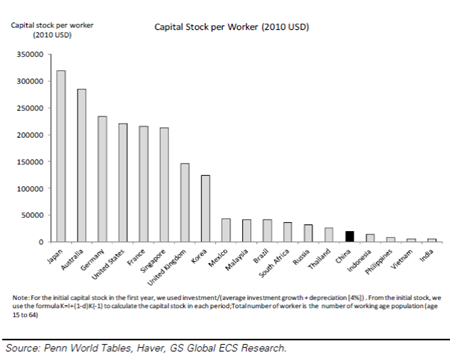For a long time, I have had huge issues with bullish arguments being made about China which are based on comparing it with some developed countries, like the US. They generally expect China to reach developed country levels of whatever-metric-they-are-talking-about in N years by extrapolating from the current growth rate.
One of the favourite metrics would be X per capita, like cars per capita, steel consumption per capita, power consumption per capita, capital stock per capita.
These arguments pull up charts like the one below, which shows that China is using less cars, less power, less steel, less gas than developed countries, then convince you that China will be like the US in a few decades time if Chinese demand of [insert product name] continues to grow at the current rate, so that it is very bullish for [insert an industry name]:
Or a chart like this, which shows that China is using less capital stock than many other countries, and convince you that China is in fact still under-investing, so that you should feel very bullish and ignore everyone who says China is over-investing:

The flaw is very obvious. First of all, while almost all China bulls seem to “know” China will become like the US, no one actually knows any such thing. In other words, the final destination of China’s economic development is uncertain. Secondly, of course, the current rate of growth is no guarantee of future performances.
And as I explained before, comparing per capita metrics of China with a developed country like the US ignores the fact that China is a much poorer country than the United States, so it is not at all surprising that China is only using a fraction of things compared with the US, and this by itself is not a justification that China will become like the US. At China’s current income level, it should be using less capital than the US, less cars than the US, less steel than Korea, less power than Europe on a per capita basis, for example. These facts tell you nothing about whether China will catch up with the developed world in these metrics.
Japan was an example of how this sort of arguments failed massively. Back in the 1980s and early 1990s, Japan was expected to become the largest economy on earth if the growth trajectory of the pre-bubble era continued. It never happened.
Michael Parker and Alex Leung of Bernstein is having the same issues:
Over the last few years, the “developmental economics” argument for Chinese power, coal, steel and cement intensity seems to have been replaced with the “up-and-to-the-right until they hit DM levels” view. The old argument went something like this: China is a big country; lots of people; most of it is a total shambles. The hounds of economic growth have been unleashed to address a half century of under-investment. Of course, power consumption growth is going up 10%+ next year. There is no end in sight.
Right about the time that Chinese power consumption in parts of the east coast reached European power consumption (Shanghai and Zhejiang now consume more power on a per capita basis than Italy or Ireland), the bull case switched from “massive, developing economy catching up on 50 years of under-investment” to one of comparative consumption: China vs the Developed World, with China gaining quickly and inevitably. The absolute upper limit became the irrefutable end state. Specifically, China is growing rapidly and has done so for the last two decades. We may be at an inflection point, but most of the time we are not at an inflection point. Therefore, China is going to keep on keeping on until it reaches US/Korean/Scandinavian levels of consumption. There is no end in sight. Throw out the S-curve and break out the ruler.
The problems, in their view:
[T]his style of analysis is that it ignores institutional challenges, technology changes, economic dynamism (or lack thereof), resource constraints, the long arc of history, the impact on the environment, changing consumer preferences, exports as a driver of commodity consumption, and how far China has already pulled forward future demand growth… not to mention the risk of a Sophomore Slump. In other words, it discards context entirely. And typically these analyses choose the US, northernEurope or north Asia as the appropriate comparison. Why not, in the case of power, Poland?
